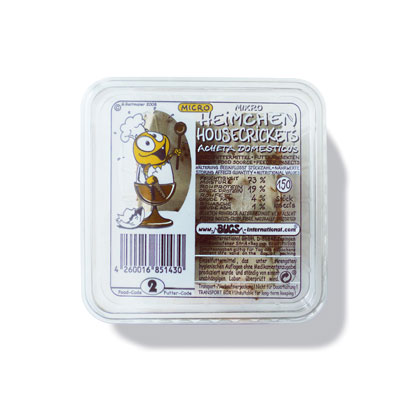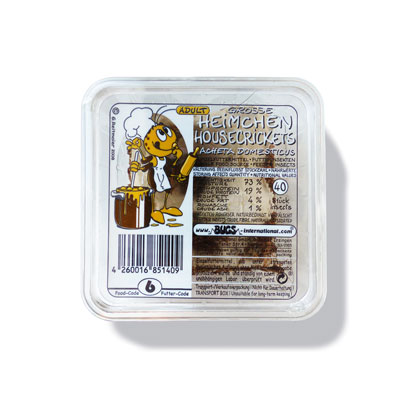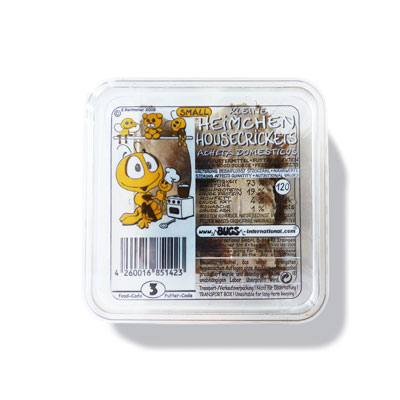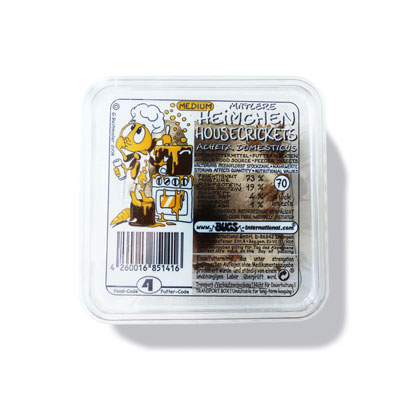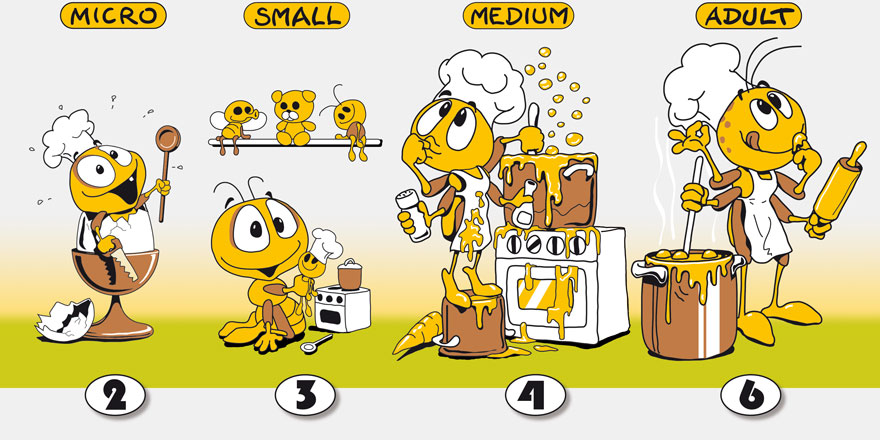
House crickets (Acheta domestica)
Text: Heiko Werning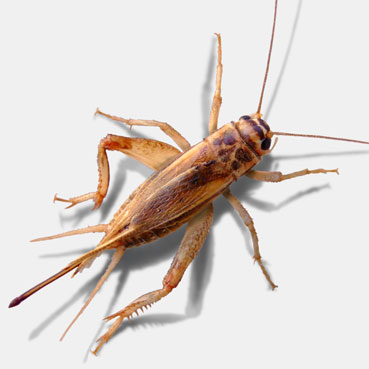
You think home is where the heart is? Sure! Ask your lizards and frogs, your tarantulas and your praying mantis, your insect-eating birds and small mammals. Even without the oven premium – the house crickets is the iconic insect amount the feeder insects. Your grandfather may have already fed his hungry leopard geckos or anolis with crickets and you can keep this tradition alive.
For almost all insect-eating reptiles, amphibians, invertebrates, fish and small mammals, the house crickets represent the basis for a healthy and balanced diet in the terrarium. At least if your feeder animals come from a healthy and reputable breeding facility and have been fed a balanced diet, as of course is the case at BUGS-international.
With a total length of up to 25 mm, house crickets are mid-sized feeder insects that – due to their different larva stages – enable a broad range of terrarium residents suitable nourishment. The house cricket, the name already alludes to it, is very robust and easy to care for. Therefore, after buying the insects at the pet store, you can care for them with little extra effort until they serve their purpose as a delicious meal for your favourite mammals or reptiles.
Even a dusting of preparations containing vitamins and minerals is not a problem in feeding of house crickets. The patient insects are easy to handle and the powder sticks to them nicely. This makes them real vitamin treats.
And who says that dog is man‘s best friend? House crickets were not only a part of the menu in your grandfather‘s terrarium, but most likely were even nestled comfortably behind the rocks of the first barbecue pit as mankind discovered fire. Because – like humans – house crickets originated in the arid regions of Africa. However, for a very long time they have been – as a result of mankind – practically present in every part of the world.
-
At the pet store you can purchase house crickets from BUGS-International in four different sizes: micro, small, medium and large. There is definitely something for everyone – from the golden poison frog and anolis baby to the grown leopard gecko or a red-eyed tree frog.
Micro house crickets still have a very light colour. Freshly hatched, they measure about 2 mm and since they are always delivered fresh by BUGS-international you will receive these little creatures in roughly this size; this way, you can even provide your smallest mammals with the perfectly portioned breeding food. Over time the small insects turn a darker colour, more beige or grey. Adult house crickets range in shades from brown to chestnut brown.
It is very easy to distinguish adult male and female house crickets: The female cricket has a long stinger attached to the abdomen. But don‘t worry – this isn‘t used for defence, but rather to lay eggs. The stinger is used precisely for this reason: The female cricket lays its eggs in a special substrate. The male crickets does not have this tool at its disposal, but has a different tool: With their wings, the insects can create chirping sounds. These sounds are rather subtle, another plus for the house cricket.
The scientific name of the house cricket is related to both of these excellent characteristics of the sympathetic multi-talented insects: „Acheta“ means „singer“ and „domesticus“ related to the fact that the insects used to live directly near to human settlements. So they‘re veritably „home singers.“ That is at least as nice as a friend of the family. And, when all is said and done, causes a lot less stress.
-
House crickets are considered easy to breed, but for those of us who have tried this ourselves will be happy that BUGS-international does all the work. Our sophisticated breeding system ensures that you will be supplied your feeder animals throughout the year, without any interruptions.
We only use the very best feed that has been especially produced to meet the needs of our house crickets. We spent years testing the perfect secret recipe, replete with minerals and trace elements. In order to be very certain, we also let an independent lab test the feed for any type of possible residue so that our house crickets are always provided with the best feed.
And of course, at BUGS-international we do not allow any unappetizing things into our feed: no medication or hormone-treated additives, growth acceleration agents or whatever else there is these days. Why would we? The nutritious foods our insects are given provided them with a healthy diet. They don‘t get sick. And of course we only use feed that does not contain discharges from land, fertilizer and agricultural pesticide residues.
However, even providing the house crickets with the best diet is not the reason for the merriness of this premium feed. That is the result of something else, too: Perfect hygienic conditions is the most important factor! Our employees and the enormous industrial washing system ensure the ongoing cleaning of all insect containers – not only at the end of a breeding cycle, but also on a regular basis during the breeding period, since the animals are always put into a new place and of course during every new formation. At high temperatures, all of the boxes in our washing system are cleaned to the highest hygienic standards. They are heat-sterilised and then disinfected. The house cricket troughs go through this procedure on a daily basis. And normally we would consider it overkill to even have to mention it, since for us it is all a matter of course. However, we unfortunately have learned from our own painful experience that in this regard nothing should be taken for granted, so we‘ll say it again anyway: Naturally we only use fresh and newly manufactured egg carton in the packaging and the breeding of our house crickets. Cartons that once contained eggs can transfer salmonellae.
Of course, that‘s a great deal of effort and it costs a bit more than if the house crickets walk through their own mud until they are sold and if they would quench their thirst by drinking bacteria-filled, billowing, decaying, stinking substrates. At BUGS-international you will always receive house crickets that have been reliably cared for year-round optimally fed and nurtured from day one. The house crickets have also been bred under the most stringent hygienic conditions and possess such excellent nutritional values that we harbour absolutely no reservations in having our insects tested by independent labs and agencies and having the results published online.
-
Advantages
• Practically always available in various sizes
• Soft feeder animals – loved by many types of animals as a part of their regular diet
• Can be easily covered with vitamin and mineral powders
• Can also be retained for a longer period of time
• Excellent nutritional valueDisadvantages:
• Somewhat loud chirping
• Active at night and relatively shy – during the day they hide in the terrarium -
The house crickets were brought to your specialised pet store in our own climate-controlled transporters and as an express delivery – we wouldn‘t actually have to care about anything else. But we do care. We didn‘t spend all of the that time carefully breeding our house crickets at great cost, using top minerals and vitamins so that they can be malnourished in their packaging and slowly starve. And, finally, only an empty shell would be shipped to our terrarium owners. We don‘t want this to happen! (And neither do our insects and animals!)
Of course, house crickets are more than capable of surviving in their transport box, especially if they are stored in cooler conditions – best case at around 16 °C to 18 °C. Once this happens, their metabolism begins slowing down and we have also provided them with enough food so that they will continue to be adequately feed and nourished.
However, the transport boxes are not suitable for longer periods. Please ensure that your crickets are not chirping street ballads or requiems, but instead are happy and healthy and leading a carefree life until they find their way into the stomach of your mammal. Safely place the contents of the transport boxes (do not squish our favourite insects!) into larger plastic boxes. The „fauna boxes“, which can be purchased at any pet store, are perfectly suited for this. These boxes also have a practical, easy-to-operate lid that enables a generous air exchange and larger house crickets can also not fall between the cracks.
In order to house small and micro house crickets, seal the box with a suitably cut piece of nylon stocking. And then take your wife out for dinner. Or the ladies splurge on something more modern, then the old man can spend his time with the crickets. As an alternative you can also use the insect screen that can be purchased at the DIY store or garden centre.
Clean cellulose or egg cartons serve interior decorative purposes. The crickets will make themselves feel at home, don‘t worry. And at the same time they have something that they can climb around on. There is only one thing missing for a cricket‘s dream home – okay, so it‘s the same thing that you want: something nice to eat and a few delicious drops of your favourite drink. It should be warm and dry, too.
Temperatures between 20 and 24 degrees Celsius are the best; it should be possible to hold these temperatures in your home. Dry and always keeping something to drink available, that might be a little more difficult. Do not place an open dish of water or a bird bath into the boxes – that only leads to a big mess or death by drowning. A small dish with a moistened cotton pad is fully sufficient; the crickets will drink to their hearts content. Dangerous germs will not have a chance – the cotton has to replaced on a regular basis, in other words on a daily basis. This also applies to the small dish.
Then place a few more treats into the box so that they do not coming into contact with the watering hole; now the crickets will feel absolutely at home. The crickets love eating muesli mixes and dog flakes. Be on the safe side and use organic products – insects don‘t think it‘s funny when they have to eat pesticides.
This way you can keep the crickets in great shape until your collection has been used up and the next delivery is made by BUGS-INTERNATIONAL to your local pet retail shop. And you will notice: The crickets are in great shape and chock full of valuable nutrients once they beginning their final journey from our home to yours. That just doesn‘t keep only the crickets happy – that also keeps the terrarium mammals happy and healthy and in the mood for reproduction!
In the wild, crickets get the moisture they need from the moisture of their feed. That means, when caring for them at home it is best to do it the same way. Crickets love fruits and vegetables.However, BEWARE:
Most people don‘t watch their own diets as much as we at BUGS-INTERNATIONAL watch the diets of our crickets. Normal fruits and vegetables from the grocery store and from the home garden can kill the insects if insecticides still adhere to them. Or it can transform the delicious titbits into a kind of dirty bomb if the terrarium mammals eat the insects that have been fed fertilizers and other „delicacies“:
In addition, please remember that all types of germs feel at home in moist areas and that the presumed fresh food can quickly mutate into a inedible and health-risking paste. In other words: don‘t overdo it! If you want to be on the safe side, just use water.
Crickets as feeder animalsThe cricket is the potato or the rice (well, in Bavaria we would say it is even the beer) for our terrarium dwellers – the number one dietary staple. It is not very fast, but it moves when it is placed into the terrarium so that the terrarium dwellers predatory instincts are awakened. For a large portion of our terrarium dwellers, the various sizes the crickets have at the different stages of their life have the perfect size. Crickets are relatively soft and additional minerals and vitamin powder sticks to them nicely.
From the newly born chameleon to the spiny-tailed monitor; from the freshly hatched bearded dragon to the grown leopard lizard; from the Carolina anole to the Madagascar day gecko – practically all insect-eating geckos love eating crickets! Of course, not just geckos: insect-eating snakes such as green snakes or meat to omnivorous turtles such as painted wood turtles and water turtles.
Even among the amphibians, the cricket is well loved; from the poison dart frog to the spotted salamander; from the Australian green tree frog to the Asian toad – not one of these creatures can resist the house crickets.Many birds, small insect-eating mammals and fish, also enjoy sinking their „teeth“ into the house cricket. For fish, BUGS-INTERNATIONAL even offers frozen food – fresh from our own insect farm sent directly into the cooler; frozen food cannot be more nutritious.
House crickets are nocturnal. That makes them an especially attractive meal to terrarium animals, such as numerous species of geckos and frogs. For mammals active during the day, the feeder animals (crickets) should be given in controlled amounts, since the crickets quickly look for a place to hide after spending a few moments with orientation to their new surroundings. Therefore, only offer them as many crickets as the terrarium dwellers can capture. Or use a pair of tweezers and feed them „by hand“.House crickets at home?
Your girlfriend isn‘t a slave to the stove, so you don‘t want her to have to find any crickets behind it, do you? Does your partner become irritated when a full-bodied chirping sound can be heard coming from behind the living room cupboard? Or maybe you are scared that one day the pest control will be ringing your doorbell with the intention of blowing up your home because one of our – we‘ve already mentioned this – very agile and wide-awake crickets escaped from your home?
Relax!If your home resembles a well organised mess, then you can even use our crickets as a small army of cleaners who can keep everything nice and tidy... ok ok let‘s be serious:
House crickets may be very adaptable, but there are very good reasons why „wild“ crickets are very rarely found in houses or flats. Our modern, centrally heated homes and flats as well as our kitchens with refrigerators instead of cooled pantries does not enable the house crickets to hunker down and nest within our four walls. The insects simply do not have any (or enough) food and water/moisture.
You do not have to fear a plaque or for that matter not even a somewhat longer stay by an undesired house guest in your living room because a cricket has escaped your watchful eye. Your escapee will not reproduce uncontrollably in your living room. It‘s not that easy for crickets to reproduce – if it was, then BUGS-INTERNATIONAL wouldn‘t go through all of these measures to keep our crickets breeding operations up and running.
So, if a cricket does escape, you do not have to live in fear that any army of crickets will invade your home. Simply use a standard sticky trap – available at your local pet supply store of garden centre. Properly placed, you will certainly avoid any missteps by your crickets.
You should only use insect sprays as a final alternative and certainly not in rooms in which you have your terrarium or the cricket boxes, since the insect spray will kill your reptiles, amphibians, fish and everything else in its path.
Alternatives
Our crickets are very charming. Who knows? Maybe you‘ll even put them into their own terrarium, far away and safe from any predators. And their „music“ will keep you entertained. To the untrained ear, the sound can be mistaken for the chirping of birds. And how many people can offer that in their homes?

